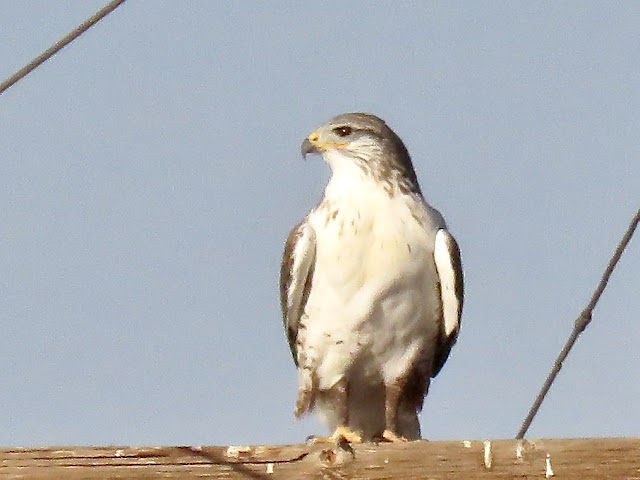Together, Lois Lorenz and Hinde Silver headed west on I-10 with me early. Having visited this area with various Audubon groups, I figured it was time for me to learn my own way around out there so I had set an agenda. With help from Lois on spotting birds from the passenger seat and from Hinde in the back seat holding my directions (plus the AZ topigraphical map), we managed to enjoy a delightful day.
Arriving before sunrise at the Lower River Road Ponds, I was able to catch the Super Moon just about to set. My camera had been in the trunk as we drove south on AZ85 while we watched it slowly drop behind one mountain range after another in dramatic fashion. Photos below are less dramatic but still indicative of the moon-set's sentient power.
 |
| Super Moon setting on 12/3/17 |
With the sunrise just beginning, we focused on many dark birds out on the pond that challenged us with shapes and sizes. A good exercise but I was really glad when enough light arrived to confirm or dash my field notes!
Lois and Hinde are both good spotters - and "counters" for my eBird data entry for our visit. My spotting scope helped us determine that the large SNOW GOOSE's two smaller companions were ROSS'S GOOSE with a very small black marble-like eye set in a very white face on a rounded head. It also has a short pointy bill.
Cormorants populated the pond in great numbers -- probably greater than the 150-count we listed, but they were constantly in and out of the air and down and up from diving in the water. We listed them as a mixed flock of DOUBLE-CRESTED and NEOTROPIC CORMORANT.
AMERICAN WIGEON dominated the duck species. GREATER YELLOWLEGS were foraging around the edges of the pond, up on a little berm above it, and flying overhead from time to time.
Our eBird list for Lower River Road Ponds is posted below.
For our next stop, I had chosen Hazen Road (from Tommy Debardeleben's birderfrommarciopa website), not far from the ponds we were leaving.
Could not imagine a better start on Hazen Road than Lois's spotting a FERRUGINOUS HAWK perched on a distant utility pole structure. I stopped quickly for photos, quietly and slowly moving forward bit by bit. Did not challenge it into flying; we knew what we were viewing and didn't need to see it in flight to make that determination of this light morph adult FEHA.
 |
| FERRUGINOUS HAWK - Adult Light morph (above and below) |
As you can see from the photos, this raptor is distinguished from a Red-tailed Hawk by its pale head, light supercilium (eyebrow), its all-while front, and feathering on its legs.
Not long after viewing that gem (not nearly as common as Red-tailed Hawk out in the ag fields), we came upon a flock of dark birds flyng into a green field.
Spend enough time in the field and you soon learn you need not see this bird's "white face" to identify it. How many species do you know that look like this in flight?
 |
| WHITE-FACED IBIS in irrgated field |
 |
| Two WHITE-FACED IBIS in basic plumage (note red eye and lack of white at base of bill present in breeding plumage) |
 |
| This WHITE-FACE IBIS was foraging alone in a field closer to us |
Raptors are abundant over open agricultural fields. At the Lower River Road ponds on a farmer's property surrounded by fields, we had seen an OSPREY, NORTHERN HARRIER, COOPER'S HAWK (2), BALD EAGLE and RED-TAILED HAWK (2).
Here on Hazen Road, we spotted NORTHERN HARRIER, COOPER'S HAWK, RED-TAILED HAWK (2) and a FERRUGINOUS HAWK.
Driving to our next destination, we came upon a field full of WESTERN MEADOWLARKs.
The air had warmed up considerably since the 49° temperature at our 7:45 a.m. start time. Now headed to Arlington Wildlife Area, we were wondering what birds we might find there.
Among the 28 species we located were: a LOGGERHEAD SHRIKE that greeted us upon arrival on a utility wire; SORA and VIRGINIA RAIL calling from within the reeds of an unseen long pond of water; MARSH WREN and SWAMP SPARROW also heard, not seen; while two SANDHILL CRANEs were audible before they were visible, so we both heard and saw those stretched-out birds in flight overhead. The GREEN-TAILED TOWHEE is always a nice surprise as was a BREWER'S SPARROW and lots of LARK SPARROWS.
 |
| LOGGERHEAD SHRIKE |
Next stop was the historic GILLESPIE DAM where we ate lunch and watched the few birds present including SNOWY EGRET (4) and AMERICAN WHITE PELICAN (3).
The count list for Arlington was broken into five segments, including the four sites listed above plus an "umbrella" count while traveling from place to place. One of the best sightings that I managed to photograph was a Dark Morph FERRUGINOUS HAWK, not a common bird. Definitely not the Harris's Hawk, but the cinnamon color in its wings had us guessing. (Harris's is almost solidly rufous in an adult).
With temperatures now allowing us to bird into the afternoon hours, we managed to get our fill of species that rarely visit our desert in the eastern stretch of Phoenix.
Just another great day of visiting with the birds (and Birders -- at Arlington Wildlife Area: Susan, Brian and Lyndie).
Click on lists below for more photos as submitted.
* * *
View this checklist online at http://ebird.org/ebird/view/checklist/S40892437
View this checklist online at http://ebird.org/ebird/view/checklist/S40892949
View this checklist online at http://ebird.org/ebird/view/checklist/S40893698
View this checklist online at http://ebird.org/ebird/view/checklist/S40894249
View this checklist online at http://ebird.org/ebird/view/checklist/S40894371








I love love love Ferruginous Hawks. I saw a couple of them this weekend! So awesome!
ReplyDeleteAgreed! Had never seen one before coming to Arizona. Gorgeous bird in every way. This was my first Dark Morph of the species - awesome!
ReplyDelete